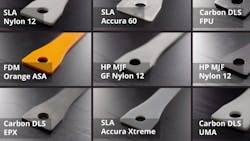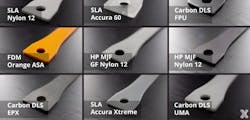Xometry’s “Will It?” engineering challenge video series puts 3D-printed parts to the test. One of the company’s videos, “Will It Vibe?” is inspired by real-world situations in which parts may undergo continuous stress, such as during transportation by car or plane.
Xometry’s Director of Application Engineering Greg Paulsen subjected nine 3D-printed test samples to continuous back-and-forth movements, which is simulated by an off-the-shelf reciprocating saw.
The question that Paulsen wanted to answer was: Can these 3D printed parts withstand sustained, repetitive motion?
Test Parameters
All printed parts were printed using fused deposition modeling (FDM), selective laser sintering (SLS), HP Multi Jet Fusion (HP MJF), stereolithography (SLA) and Carbon DLS. The parts were the ASTM test sample standard size of 4 × 0.75 x 0.08 in. and underwent the same conditions. Among these:
- The saw’s rate of reciprocation was based on 50% power to the saw (half trigger pull)
- The jig held the saw blade and allowed the 3D-printed sample part to attach perpendicular to the saw motion
- The test sample had a metal bolt mounted to the top to add weight and intensify oscillation during the short test timeframe
Results
Paulsen found that three test samples failed: FDM ASA, Carbon DLS EPX and SLA Accura 60. During the experimental debrief, he attributed the failure of these parts to the mechanical characteristics of each individual material, as well as the process by which it was 3D printed.
Thermoplastics typically exhibit higher flexibility and ductility, which why the laser sintered parts (HP Multi Jet Fusion and SLS) passed the test. These parts have fairly uniform, or isotropic, mechanical properties from the laser sintering printing process. The failed thermoplastic (FDM ASA) likely failed at the filament level, which ultimately worked across the part, causing it to snap in two.
The thermosets used in the test were the Carbon DLS and SLA materials. SLA materials are typically known for being brittle, which resulted in Accura 60’s failure to withstand vibration because it had a brittle profile similar to polycarbonate. While Carbon DLS materials all exhibited durable isotropic properties, these engineered resins range widely in characteristics. The EPX thermoset failed because it is known to be a stiff material with low flexibility.
Xometry is looking for its next engineering challenge—submit a request and see if yours gets picked.
Serena Ngoh is a senior marketing specialist for Xometry.

